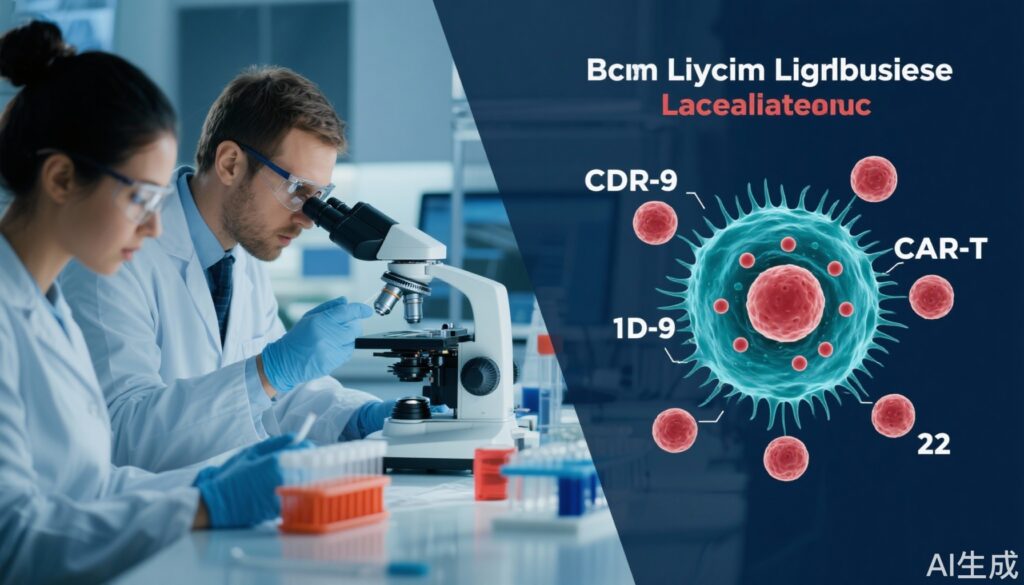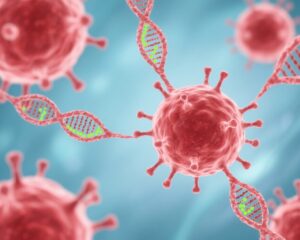Highlight
– Tandem CD19/CD22 CAR T-cell therapy achieved complete remission in 80% of heavily pretreated pediatric and young adult patients with r/r B-ALL at 28 days post-infusion.
– Combination with consolidative hematopoietic stem cell transplantation (HSCT) yielded an 18-month overall survival of 70%.
– High-grade cytokine release syndrome (CRS) and immune effector cell-associated neurotoxicity syndrome (ICANS) correlated with preinfusion high tumor burden (TB), emphasizing the need for effective bridging therapy.
Study Background and Disease Burden
Relapsed/refractory B-cell acute lymphoblastic leukemia (r/r B-ALL) remains a significant clinical challenge, particularly in pediatric, adolescent, and young adult (AYA) populations. Despite remarkable success using chimeric antigen receptor T-cell (CAR T-cell) therapies targeting CD19, disease relapse frequently occurs, often due to antigen loss or escape mechanisms. This necessitates innovative strategies to target multiple antigens simultaneously to reduce relapse rates and improve durable remissions. Tandem CAR T-cells targeting both CD19 and CD22 antigens have emerged as a promising approach to overcome antigen escape and improve treatment outcomes in this high-risk group.
Study Design
This report details compassionate use data from a single-center Spanish cohort involving 10 heavily pretreated pediatric and AYA patients with high-risk r/r B-ALL, including patients with Down syndrome. Key inclusion criteria comprised prior multiple lines of therapy, with most having undergone previous anti-CD19 CAR T-cell therapy and/or hematopoietic stem cell transplantation (HSCT).
The intervention consisted of administration of tandem anti-CD19/CD22 CAR T-cells. Key baseline assessments included tumor burden evaluation and inflammatory markers (IL-6, LDH, ferritin) before lymphodepletion. Outcomes measured were safety (notably cytokine release syndrome [CRS] and immune effector cell-associated neurotoxicity syndrome [ICANS]), complete remission (with minimal residual disease [MRD] status), and overall survival up to 18 months post-infusion.
Key Findings
Among the 10 patients treated, nine had relapsed disease, with seven previously exposed to anti-CD19 CAR T-cell therapy and six having undergone HSCT. Two patients had Down syndrome, illustrating inclusion of vulnerable populations. The pre-infusion tumor burden varied, with a subset presenting high disease burden, which correlated with elevated inflammatory markers and higher rates of severe CRS and ICANS.
Efficacy outcomes were notable: eight out of ten patients achieved complete remission by day 28 post-infusion, with seven attaining MRD-negative status. Consolidative HSCT was performed within three months in five of the seven patients with available follow-up data post-remission. Two patients experiencing early relapse after tandem CAR T-cell therapy successfully underwent rescue therapies including additional HSCT.
Importantly, the 18-month overall survival was 70% (95% confidence interval: 47%-100%), a promising figure considering the heavily pretreated and high-risk nature of the cohort.
Regarding safety, the incidence of high-grade CRS and neurotoxicity was associated with baseline tumor burden, underscoring the clinical imperative to optimize bridging therapy and reduce leukemic burden before CAR T-cell infusion to mitigate severe toxicities.
Expert Commentary
These preliminary clinical data support the feasibility and potent anti-leukemic effect of tandem CD19/CD22 CAR T-cells in a difficult-to-treat pediatric/AYA population with high-risk r/r B-ALL. The dual-antigen targeting approach addresses antigen escape, a common cause of relapse after single-antigen CAR T-cell therapies.
However, challenges remain to optimize safety, particularly in patients with high tumor burden at infusion, who are at increased risk for severe cytokine-mediated toxicities such as CRS and ICANS. The management of bridging therapy to reduce tumor load before infusion and rigorous monitoring of inflammatory markers are critical to improving clinical outcomes.
The integration of consolidative HSCT post-CAR therapy appears to enhance disease control and durability of remission, although the timing and patient selection criteria warrant further study. Ongoing clinical trials such as the REALL_CART trial (NCT06709469) will provide more definitive guidance on efficacy and safety in larger cohorts.
While limited by small sample size and lack of a control arm, this compassionate use study importantly includes heavily pretreated patients and those with comorbidities (Down syndrome), enhancing the generalizability of its findings to real-world clinical practice.
Conclusion
The administration of tandem CD19/CD22 CAR T-cells offers a promising therapeutic advance for children and young adults with high-risk relapsed/refractory B-ALL, demonstrating high rates of complete remission and encouraging intermediate-term survival when combined with consolidative HSCT. Key clinical challenges include mitigating toxicity related to baseline tumor burden and refining bridging strategies before infusion. Further prospective controlled studies are warranted to validate these encouraging results and optimize treatment protocols.
References
1. González-Martínez B, Galán-Gómez V, Navarro-Zapata A, et al. Tandem CD19/CD22 CAR T-cells as potential therapy for children and young adults with high-risk r/r B-ALL. EBioMedicine. 2025 Aug;118:105872. doi:10.1016/j.ebiom.2025.105872.
2. Park JH, Riviere I, Gonen M, et al. Long-Term Follow-up of CD19 CAR Therapy in Acute Lymphoblastic Leukemia. N Engl J Med. 2018;378(5):449-459.
3. Maude SL, Laetsch TW, Buechner J, et al. Tisagenlecleucel in Children and Young Adults with B-Cell Lymphoblastic Leukemia. N Engl J Med. 2018;378(5):439-448.
4. Fry TJ, Shah NN, Orentas RJ, et al. CD22-targeted CAR T cells induce remission in B-ALL that is naïve or resistant to CD19-targeted CAR immunotherapy. Nat Med. 2018;24(1):20-28.
Funding support information has been acknowledged as per the original publication.


